Since the beginning of agriculture, the battle between weeds and farmers has been constant as weeds continue to adapt to management practices in order to survive. The struggle continues today with waterhemp and Palmer amaranth, two pigweed species that have become especially problematic for Illinois soybean farmers due to their inherently competitive characteristics and evolved resistance to several classes of herbicides. To curb this threat, farmers need to adopt an integrated, zero-tolerance approach to pigweed management, which is the goal of BASF’s Operation Weed Eradication.
Before developing a plan for controlling waterhemp and Palmer amaranth, it’s important to understand their strengths, which are many, and weaknesses, which are few. They grow quickly, are prolific seed producers, and they germinate at shallow soil depths, meaning they have adapted well to conservation tillage practices. Additionally, because both waterhemp and Palmer amaranth have separate male and female plants that cross-pollinate, genetic diversity within populations is high. This, combined with their prolific seed production, favors the quick development and spread of herbicide resistance.
That being said, waterhemp and Palmer amaranth do have some weaknesses. Their tendency for shallow germination means seeds buried below about 1/2 inch are unlikely to emerge. They also have relatively limited seed viability in the soil, as 5 percent or less of seeds remain viable in the soil after three years1. Exploiting these weaknesses is important for farmers to gain the upper hand. As a result, aggressive management can quickly restore “train wreck” or “insufficient management” situations, like the ones pictured below, to a manageable one that approaches the ultimate goal of eradication. But first, farmers must also consider what they can and cannot do, and what they are willing to do.
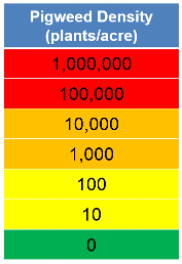
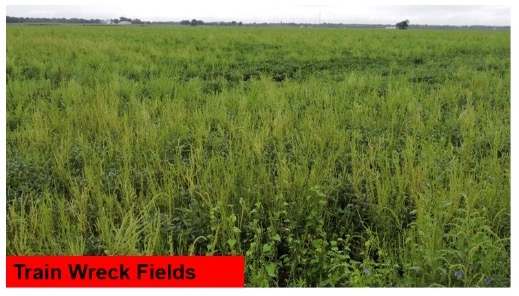
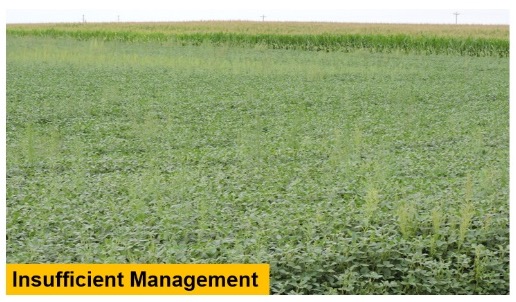
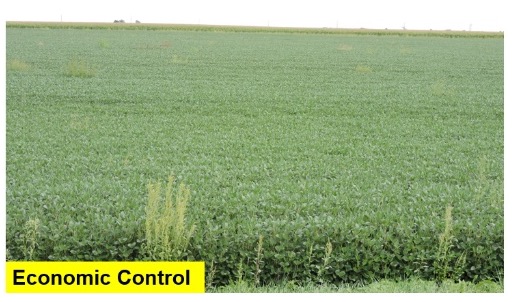
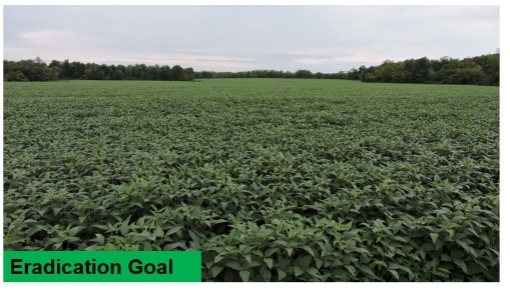
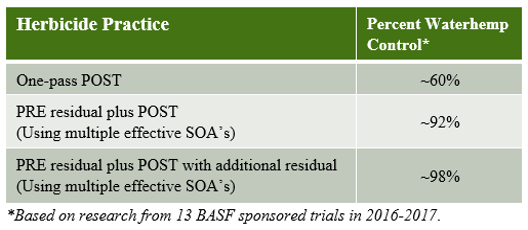 While an integrated management approach is the ultimate goal, selecting the right herbicides for pigweed control is foundational. Because the best way to control weeds is to prevent them from emerging, a chemical weed control program should start with a pre-emergence residual herbicide with multiple effective modes of action that will prevent waterhemp and Palmer amaranth emergence for several weeks after application. An effective post-emergence herbicide(s) should be used, ideally targeting weeds when they are less than three inches tall. Optimize these applications by using the correct nozzle type and size, carrier volume, sprayer speed, and adjuvants for the herbicide(s) being used. The final step that many growers can take is including another residual herbicide in the post-emergence pass, which overlaps with the first residual and continues to prevent weed emergence. A well-rounded herbicide program like this should control most of the weeds that year and set the foundation for an integrated weed management program.
While an integrated management approach is the ultimate goal, selecting the right herbicides for pigweed control is foundational. Because the best way to control weeds is to prevent them from emerging, a chemical weed control program should start with a pre-emergence residual herbicide with multiple effective modes of action that will prevent waterhemp and Palmer amaranth emergence for several weeks after application. An effective post-emergence herbicide(s) should be used, ideally targeting weeds when they are less than three inches tall. Optimize these applications by using the correct nozzle type and size, carrier volume, sprayer speed, and adjuvants for the herbicide(s) being used. The final step that many growers can take is including another residual herbicide in the post-emergence pass, which overlaps with the first residual and continues to prevent weed emergence. A well-rounded herbicide program like this should control most of the weeds that year and set the foundation for an integrated weed management program.
Mechanical control practices usually involve some type of tillage or cultivation. For someone starting out in a “train wreck” scenario, aggressive tillage like moldboard or chisel plowing should be considered. This will bury the weed seeds below the germination zone where they will likely remain and die. Other options are using a field cultivator or disk in the spring to remove emerged weeds prior to planting. Because pigweed emergence in the state doesn’t typically take off until early- to mid-May, using an in-row cultivator after crop emergence may be an option later in the season. For some Illinois growers, tillage may not be an option depending on the topography, and other practices should be considered.
Cultural control includes a wide range of options, so let’s focus on a few key ones. Crop rotation is a practice that many growers are already using that allows for the cycling of crop-specific herbicides each year. Planting narrow-row soybeans should also be considered, as it leads to quicker canopy closure to prevent sunlight from reaching germinating weeds, and it has also been shown to consistently yield more than wide-row soybeans. Cover crops are also gaining popularity, which could be an alternative for growers who cannot utilize tillage. Winter wheat, for example, is a very competitive crop that is already established when waterhemp and Palmer amaranth are germinating and can be harvested for yield. Additionally, mowing field edges, keeping drowned-out spots in fields weed-free, and cleaning equipment between fields are other small actions that can have a major impact.
Integrating several of these weed management strategies is likely to control the vast majority of the pigweeds growers face and lead to “economic control” levels; however, no program can guarantee 100 percent weed control, and that is where the last and most important step comes in. Hand-weeding is the final step of eradication by removing any remaining weeds in the field and preventing potentially hundreds of thousands of new seeds from entering the soil seed bank. These last survivors are the most important ones to control, as they may be the beginning of herbicide resistance or the population could be shifting towards later emergence.
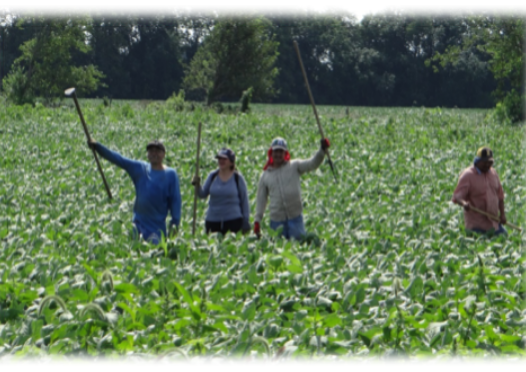
Let’s be honest: the idea of hand-weeding is not the most appealing concept, and many growers who consistently achieve economic control may not see the need for this final step. But those growers should also consider the risk involved if something should go wrong. One bad year could be all it takes to go from economic control to train wreck (consider all the prevent plant acres in 2019 as an example), and that is hard to recover from. By hand-weeding those last few escapes, that risk is being removed and the weeds are relying on last year’s seeds, many of which will not survive! And, if other management practices are used, hand-weeding is not as troublesome as it may initially seem, especially considering the benefits.
While complete eradication of waterhemp and Palmer amaranth from the face of the Earth is not realistic, the eradication of these weeds from individual fields is very much a reality. By taking a zero-tolerance approach, the battle against these troublesome weeds is one that we can win!
1Korres, N. E., Norsworthy, J. K., Young, B. G., Reynolds, D. B., Johnson, W. G., Conley, S. P., Smeda, R.J., Mueller, T.C., Spaunhorst, D.J., Gage, K.L., Loux, M., Kruger, G.R., & Bagavathiannan, M. V. (2018). Seedbank persistence of Palmer amaranth (Amaranthus palmeri) and waterhemp (Amaranthus tuberculatus) across diverse geographical regions in the United States. Weed Science, 66(4), 446-456.




 and then
and then